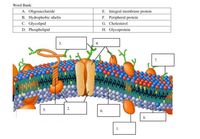
Human Anatomy & Physiology (11th Edition)
11th Edition
ISBN: 9780134580999
Author: Elaine N. Marieb, Katja N. Hoehn
Publisher: PEARSON
expand_more
expand_more
format_list_bulleted
Concept explainers
Question

Transcribed Image Text:Word Bank:
A. Oligosaccharide
B. Hydrophobic ahelix
C. Glycolipid
D. Phospholipid
E. Integral membrane protein
F. Peripheral protein
G. Cholesterol
H. Glycoprotein
3.
4.
7.
5.
2.
6.
8.
1.
Expert Solution
This question has been solved!
Explore an expertly crafted, step-by-step solution for a thorough understanding of key concepts.
Step by stepSolved in 2 steps with 1 images

Knowledge Booster
Learn more about
Need a deep-dive on the concept behind this application? Look no further. Learn more about this topic, biology and related others by exploring similar questions and additional content below.Similar questions
- Write 2 (any) functions of membrane carbohydrates and explain the functions.arrow_forwardFat is stored in adipose cells in the body, and glycoproteins are produced by liver cells. Which of the following is likely to be more prominent in adipose cells than in liver cells? A B с D cell membrane smooth endoplasmic reticulum nucleus rough endoplasmic reticulumarrow_forwardThe interface formed between two hydrophobic molecules in the context of the aqueous environment of the cell cytoplasm is formed mostly through: A. Hydrogen bonds B. Covalent bonds C. Van der Waals interactions D. Ionic bonds E. None of the abovearrow_forward
- Consider the following diagram of the cell membrane. Which of the statements is NOT true regarding the cell membrane? Group of answer choices a. Proteins and carbohydrates are also components of the cell membrane. b. Certain phospholipids and proteins on the outer surface of the cell membrane are attached to carbohydrates. c. Some carbohydrates extend through the entire lipid bilayer and appear on both surfaces of the membrane d. Some of the proteins embedded in the cell membrane constitute channels (passage canals).arrow_forwardDiscuss the permeability of the phospholipid bilayer to the molecules and ions listed below. Is the bilayer freely permeable, somewhat permeable, or impermeable to each of these? 1. OH- 2. H* 3. 0₂ 4. C6H12O6 5. H₂O 6. CO₂ Which is not a major function of the protein in cell membranes? They are important for membrane transport They are important for cell-to-cell joining They function as enzymes They regulate membrane fluidity Which is not true about cell membranes? They frequently flip-flop from one side of the membrane to the other - They can move freely within one side of the bilayer Fatty acid tails of phospholipids form the membrane interior The interior of the bilayer is hydrophoicarrow_forwardFor biological membranes, which of the following statement is NOT true? A. The phospholipid bilayer is a fluid matrix. B. Protein can be anchored to the membrane by covalently linked lipid chains. C. Proteins can move laterally across the membrane. D. For organisms living in cold temperature, their cell membranes contain more triacylglycerols. E. Transverse motion of lipid molecules can occur occasionally. Enzyme lowers when... A. The energy difference between the substrate and the transition state B. The energy difference between the product and the transition state C. Both A and B D. Neither A nor Barrow_forward
- Which of the following compounds can diffuse through the lipid bilayer of a cell membrane? Select all that apply. A. Large polar molecules B. Gases and hydrophobic molecules C. Ions D. Small polar molecules like waterarrow_forwardThe following are functions of lipids EXCEPT A. Isolate cellular components from its environment B. Serve as signal molecules and mediators of cellular processes C. Membrane fluidity determinant D. Alternative energy source of cells O E. Facilitate movement of metabolites in and out of cellsarrow_forward3) For each case given below, describe how the fluidity of membranes will change (increase or decrease) and why this change will happen. A. Increasing the number of double bonds (unsaturation) of the fatty acids in the phospholipids. B. Increasing the length of the fatty acid chains. C. Increasing the cholesterol content of the membrane D. Increasing temperaturearrow_forward
arrow_back_ios
arrow_forward_ios
Recommended textbooks for you
 Human Anatomy & Physiology (11th Edition)BiologyISBN:9780134580999Author:Elaine N. Marieb, Katja N. HoehnPublisher:PEARSON
Human Anatomy & Physiology (11th Edition)BiologyISBN:9780134580999Author:Elaine N. Marieb, Katja N. HoehnPublisher:PEARSON Biology 2eBiologyISBN:9781947172517Author:Matthew Douglas, Jung Choi, Mary Ann ClarkPublisher:OpenStax
Biology 2eBiologyISBN:9781947172517Author:Matthew Douglas, Jung Choi, Mary Ann ClarkPublisher:OpenStax Anatomy & PhysiologyBiologyISBN:9781259398629Author:McKinley, Michael P., O'loughlin, Valerie Dean, Bidle, Theresa StouterPublisher:Mcgraw Hill Education,
Anatomy & PhysiologyBiologyISBN:9781259398629Author:McKinley, Michael P., O'loughlin, Valerie Dean, Bidle, Theresa StouterPublisher:Mcgraw Hill Education, Molecular Biology of the Cell (Sixth Edition)BiologyISBN:9780815344322Author:Bruce Alberts, Alexander D. Johnson, Julian Lewis, David Morgan, Martin Raff, Keith Roberts, Peter WalterPublisher:W. W. Norton & Company
Molecular Biology of the Cell (Sixth Edition)BiologyISBN:9780815344322Author:Bruce Alberts, Alexander D. Johnson, Julian Lewis, David Morgan, Martin Raff, Keith Roberts, Peter WalterPublisher:W. W. Norton & Company Laboratory Manual For Human Anatomy & PhysiologyBiologyISBN:9781260159363Author:Martin, Terry R., Prentice-craver, CynthiaPublisher:McGraw-Hill Publishing Co.
Laboratory Manual For Human Anatomy & PhysiologyBiologyISBN:9781260159363Author:Martin, Terry R., Prentice-craver, CynthiaPublisher:McGraw-Hill Publishing Co. Inquiry Into Life (16th Edition)BiologyISBN:9781260231700Author:Sylvia S. Mader, Michael WindelspechtPublisher:McGraw Hill Education
Inquiry Into Life (16th Edition)BiologyISBN:9781260231700Author:Sylvia S. Mader, Michael WindelspechtPublisher:McGraw Hill Education

Human Anatomy & Physiology (11th Edition)
Biology
ISBN:9780134580999
Author:Elaine N. Marieb, Katja N. Hoehn
Publisher:PEARSON

Biology 2e
Biology
ISBN:9781947172517
Author:Matthew Douglas, Jung Choi, Mary Ann Clark
Publisher:OpenStax

Anatomy & Physiology
Biology
ISBN:9781259398629
Author:McKinley, Michael P., O'loughlin, Valerie Dean, Bidle, Theresa Stouter
Publisher:Mcgraw Hill Education,

Molecular Biology of the Cell (Sixth Edition)
Biology
ISBN:9780815344322
Author:Bruce Alberts, Alexander D. Johnson, Julian Lewis, David Morgan, Martin Raff, Keith Roberts, Peter Walter
Publisher:W. W. Norton & Company

Laboratory Manual For Human Anatomy & Physiology
Biology
ISBN:9781260159363
Author:Martin, Terry R., Prentice-craver, Cynthia
Publisher:McGraw-Hill Publishing Co.

Inquiry Into Life (16th Edition)
Biology
ISBN:9781260231700
Author:Sylvia S. Mader, Michael Windelspecht
Publisher:McGraw Hill Education